Black & White Toning/Bang Chang/Digital Photo Frame Primer

Quick Click Links
Feature Photograph Bang Chang Digital Photo Frame Primer
Photography News of Interest
Readers Submissions Readers Questions
A Snapshot of Bangkok Images Week in Review
I
nfocus Blog, No Other Lifetimes
T
Feature Photograph *menu

Canon 1ds Mark II, 90mm F2.8 TSE @F8 15 secs ISO 200
Our fourth entry in our series on digital toning will center on the most popular of toning which you probably know as “black & white.” As we’ve previously discussed, digital toning
presets are a popular feature set in Lightroom and most imaging software. We’ll be exploring the genesis of the most common toning presets and how they apply to our photography. Check out the first in the series about Cyanotypes
, the second on Sepia,
and the third on Antique Toning.
Black and white photography has been with us since the beginning and unlike the other toning types, black and white goes well with almost anything. Some people prefer to shoot nothing but black and white finding colors distracting to their compositions. There is a bit of a misnomer out there that black and white is simple to master. It’s not. It’s at least as complex and difficult to master as color. There are simple ways to achieve a black and white image, but these are usually employed by beginners who haven’t yet learned to look for light, tones, grays, and how these interact among different subjects in the composition to achieve a final composition. “How” you convert an image, is just as important as the composition itself. It needs to fit and look right.
The image above is one of my favorites from Cambodia. A 15 second capture after dark where you couldn’t see anything with the naked eye. The variety of tones, the depth of the blacks, and the extended tonal range throughout make this image work.

Canon 1ds Mark II, 90mm F2.8 TSE @F8 15 secs ISO 200
This is the same image straight out of the camera. It’s really not attractive at all, but if you gain experience with black and whites you’ll notice all the tone ranges across the water and in the sky and you’ll know it will make a good black and white image, if properly toned.

Canon 1ds Mark II, Sigma 12-24mm F4.5-5.6 @F8 30 secs 13mm ISO 100
Another long exposure of 30 seconds. I loved this view and knew when I looked through my viewfinder that I’d process it in black and white. Why? I wanted to show the length of the corridor, the detail of the rocks, the reflections on the floor, and the ghost of Angkor photographers. I wanted the viewer to concentrate on these important points and not be distracted by color or mixed tones.

Canon 1ds Mark II, Sigma 12-24mm F4.5-5.6 @F8 30 secs 13mm ISO 100
Can you see the difference? The same detail and view is there, but it doesn’t seem like it because your eyes are being distracted.
Black and white is appropriate for most everything, but unless you’re really good at it you might want to limit it to series of photographs where you want to include a certain mood or feeling. Making an effective/attractive black and white image is much more than just sliding the saturation slider to the left. It’s about ‘feeling’ the image and getting the very most from it, trying different levels, different looks, much like we’d do in the darkroom long ago.
Bang Chang *menu
Bang Chang is a bit of a well kept secret about 20km further down the road from Pattaya. It’s a slow town with a good sized expat community, its own expat bar area, and some really decent restaurants and golf courses. Every now and then I get down there to visit friends and you’ve seen my coverage of this area before.
This time I wanted to visit with a friend and planned on staying two days and hitting some of my favorite places in the area and discovering some new ones. I wasn’t even there six hours before I learned I’d have to cut my trip short by a day and I’d have barely 5-6 hours the next morning to grab some photographs.
As a result I couldn’t really come up a real ‘Feature Destination’, but I did come up with some subjects to chat about a bit and get your reading on future coverage.

Canon 5d Mark II, Sigma 12-24mm F4.5-5.6 @F11 1/400th 15mm ISO 100
Let’s start with a finished image of my favorite lighthouse. It’s really a show front for a long defunct housing project but I like it just the same. Heck, I’d like one in my backyard. J Set against a sea wall with the ocean on one side and trees on the other, you can easily imagine the bright light warning ships during inclement weather.

Canon 5d Mark II, Sigma 12-24mm F4.5-5.6 @F11 1/400th 15mm ISO 100
This was the original capture. Does it look different before I process it? I showed this ‘before’ image to get your feedback on future tutorials. Do you want to learn to use the skew function to straighten the fence and make the lighthouse set straight up/down? CS5’s Content Aware feature to replace backgrounds and make power lines go away? Localized Editing to selectively expose certain parts of the scene? Let me know what you’d like covered in the future and I’ll work up some tutorials.
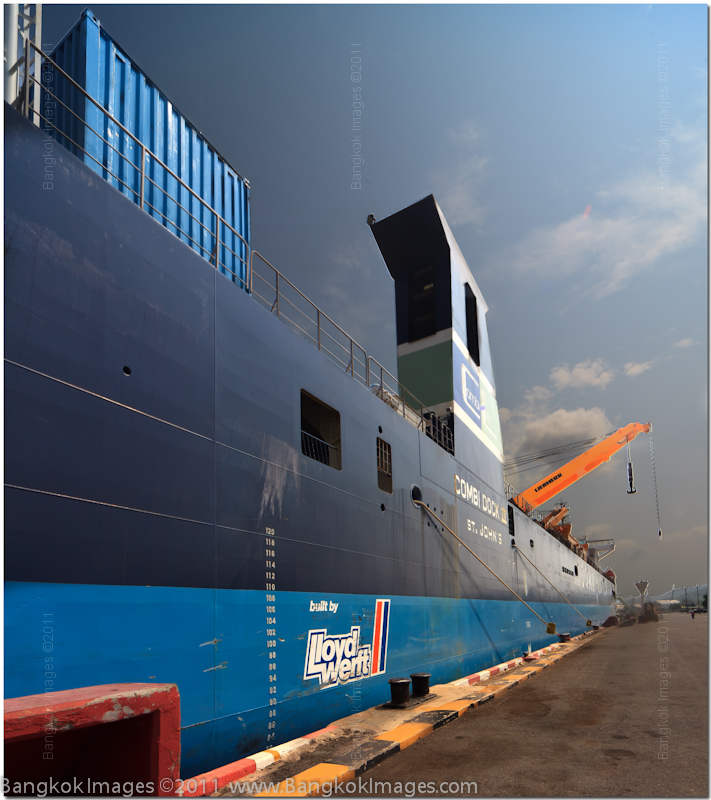
Canon 5d Mark II, Sigma 12-24mm F4.5-5.6 @F11 1/250th 15mm ISO 100
Before the lighthouse we were down at the military docks checking out a cargo ship which carried supplies for the Cobra Gold military exercise. These small container ships are capable of loading and offloading much faster than the bigger container ships and they can push about 10 more knots while at sea. This makes them useful for supplying short notice or small military actions and building projects.
Here I used an ultra-wide 15mm’s to show the lines of the ship, from the stern to bow.
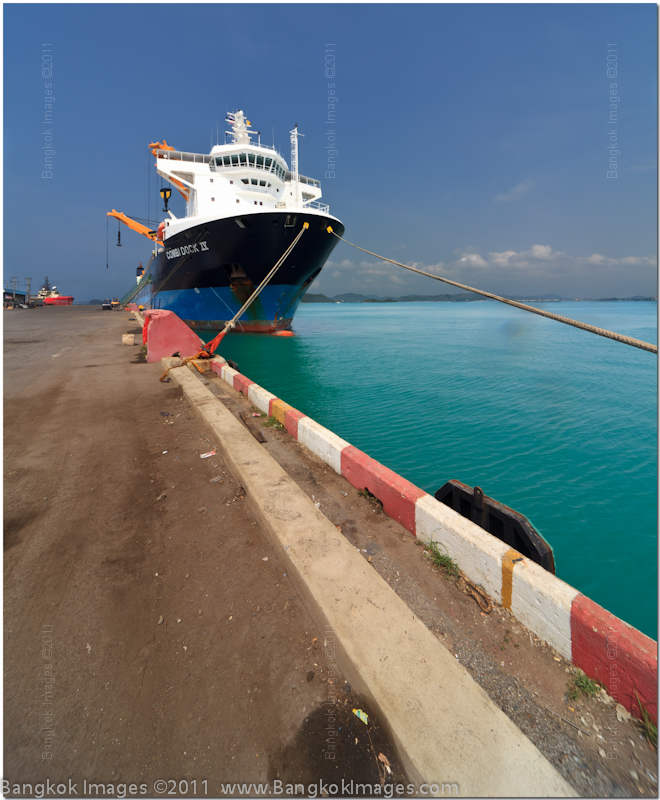
Canon 5d Mark II, Sigma 12-24mm F4.5-5.6 @F11 1/160th 12mm ISO 100
As we swing around to the front of the same ship it looks a bit different. The superstructure looms with the cranes behind, and the long mooring lines add interest. At 12mm we were able to see a good portion of the background and the entire ship. But could we make a more interesting photograph?
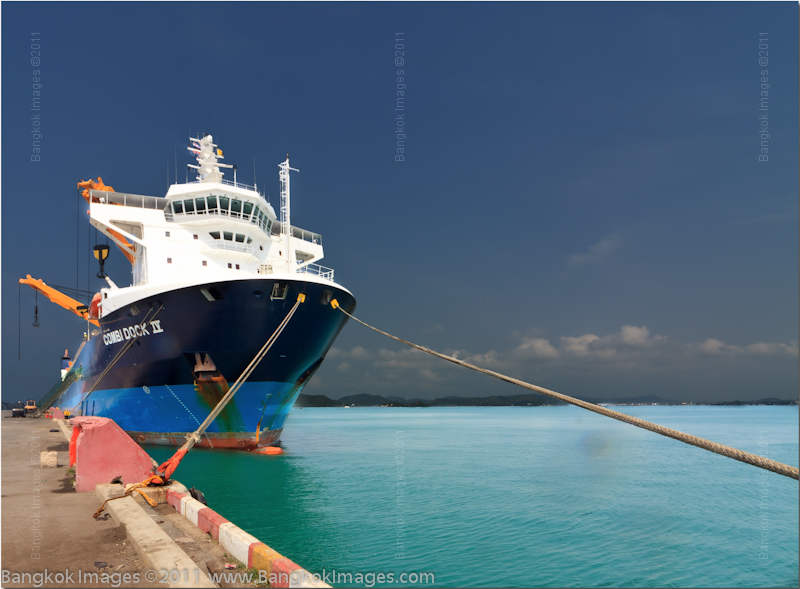
Canon 5d Mark II, Sigma 12-24mm F4.5-5.6 @F11 1/160th 12mm ISO 100
Cutting about half the distance to the ship we now have a more powerful composition. We can see the ship more clearly than before, the lines still add interest, and with the 12mm lens it appears we’re far from the ship. In reality we’re less than 20 feet from the ship which isn’t much considering the ship is several stories high.
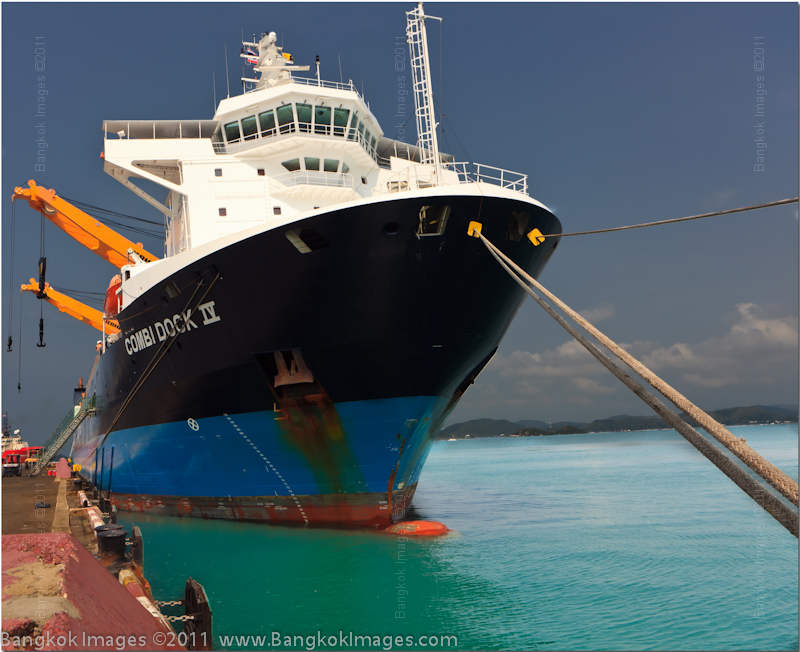
Canon 5d Mark II, Sigma 12-24mm F4.5-5.6 @F11 1/160th 24mm ISO 100
Now I’ve again cut the distance in half, went to 24mm for the least perspective distortion possible, and the ship looms in front of the camera. You feel like you can reach out and grab the mooring line and see the pilot in the window. The cranes take on more presence and are clearly detailed. Small details like the white waterline markers are visible on the hull. The ship becomes much more interesting while the background disappears.
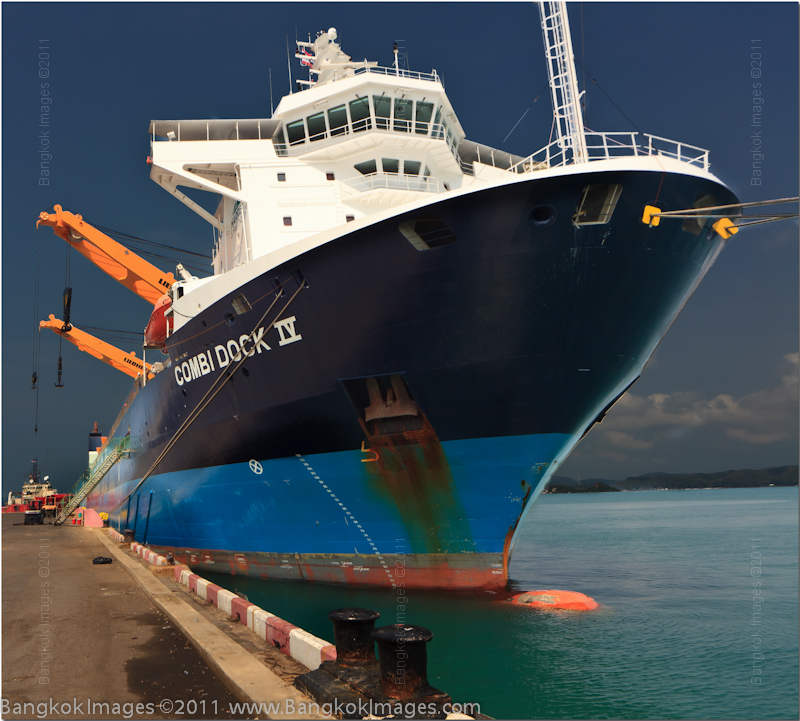
Canon 5d Mark II, Sigma 12-24mm F4.5-5.6 @F11 1/160th 24mm ISO 100
Yes, we can get even closer! And by moving the camera to the left we’re now showing more of the cranes, gangway, and work along the side of the ship, and the superstructure looks even more imposing and detailed. These are the decisions you make when you look through the viewfinder and decide on your composition. You ask yourself questions such as what are the more important features you which to be most prominent, which details are the most interesting, and do you want the ship to be 100% of the composition or do you want to bring the background into play.
With such a great subject you might not be able (or want) to decide on a single composition. Why limit yourself? Make several captures and decide later which one you consider the strongest. Just be sure to notice all the different compositional elements and make the captures you do get as meaningful as possible.
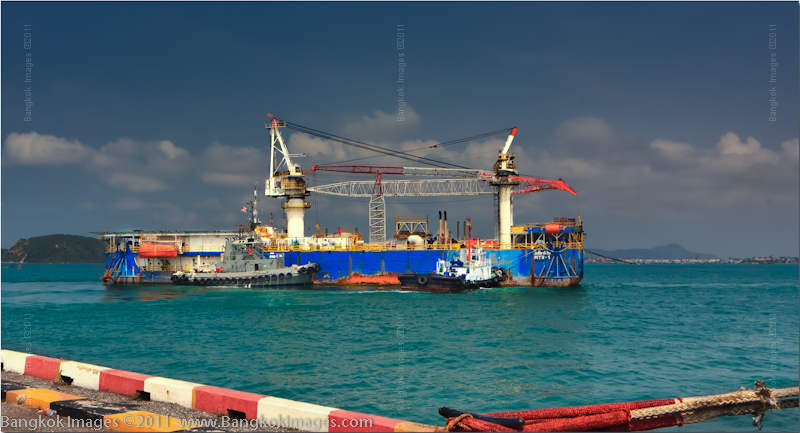
Canon 5d Mark II, Sigma 12-24mm F4.5-5.6 @F11 1/250th 24mm ISO 100
At the other end of the pier I noticed this utility derrick being towed by a big tug and pushed by two smaller tugs. Full of color on a clear azure sea, how can you resist? It’s just another relatively vessel, but it’s colorful and interesting to those who have never seen one. With an island in the background be sure to include a foreground. Remember the rules for a successful landscape? Try hard to include a foreground, mid-ground, and background. Here we have all three. I had to remind myself to back up and catch part of the dock to use as a foreground.
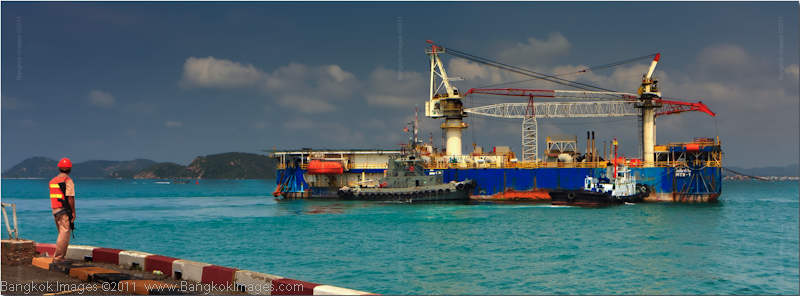
Canon 5d Mark II, Sigma 12-24mm F4.5-5.6 @F11 1/250th 24mm ISO 100
Another view were I used the M16 toting Thai security guard watching the derricks movement as a foreground. You can also see more of the island. It might look like you have only one shot, but you almost always have several.
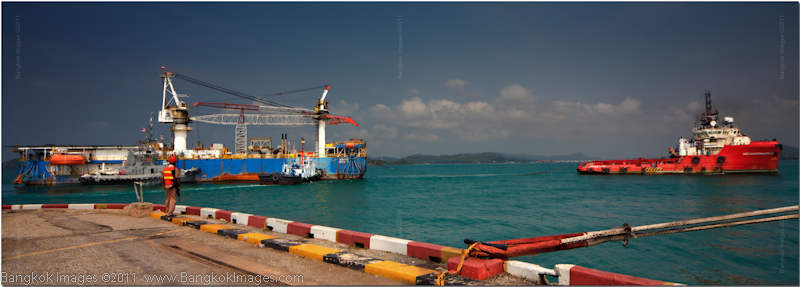
Canon 5d Mark II, Sigma 12-24mm F4.5-5.6 @F11 1/320th 21mm ISO 100
This is my favorite from the three. The huge tug towing the derrick is visible as are the two pushing tugs, the dock, the guard, all the elements are present. I’ll be making a 30 inch wide print of this image and the detail will be incredible.
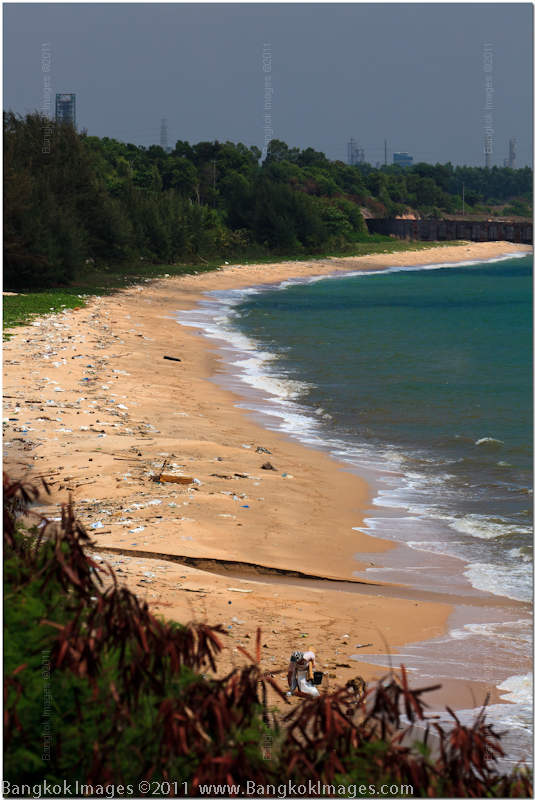
Canon 5d Mark II, 70-200mm F2.8L IS USM @F11 1/640th 200mm ISO 100
Another sad subject. Below the lighthouse project is a beach literally covered in garbage. Mostly plastic bags like you get at 7-11 or the grocery store. A beautiful serene beach with natural foliage right up to the sand. What could have been a picturesque dream becomes an affront to our environment. I processed this image to show the garbage. Without the garbage I would have processed it completely different.
Your first inclination is to blame the garbage on the local Thais. This is where studying your scene comes in handy. Notice three local Thais working on cleaning up the beach? I’ll bet it’s a full time job.
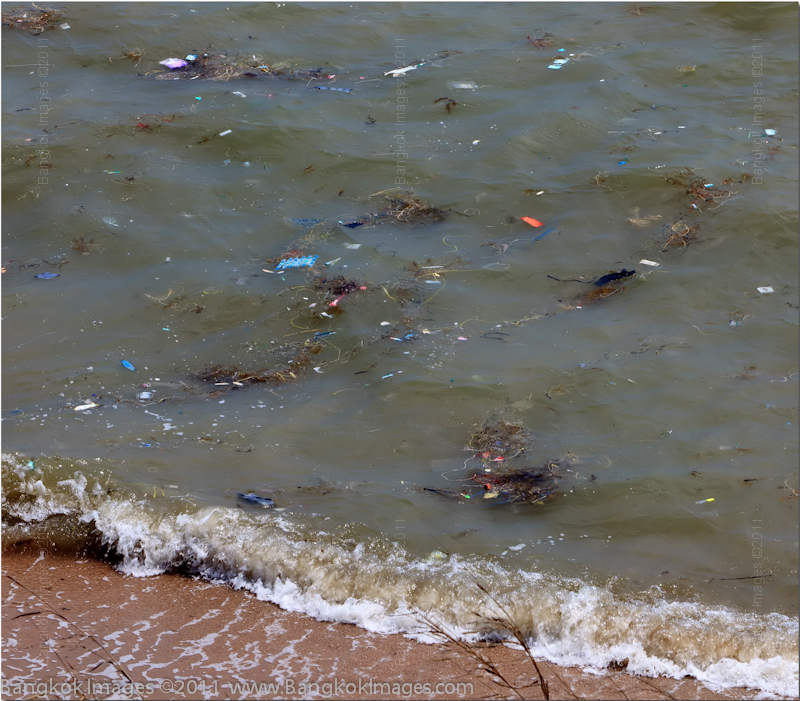
Canon 5d Mark II, 70-200mm F2.8L IS USM @F11 1/250th 115mm ISO 100
This close up of the surf-line shows where the trash really comes from. Off-shore, from vessels dumping their garbage before docking to avoid garbage collection fees while in port. Why is this allowed? The local residents I’m sure have been complaining to the authorities for a long time, yet their complaints fall on deaf ears. Is this because the ports generate tons of income while the locals who control the beach generate very little?
The Thai authorities should be ashamed. This beach extend at least 10 km that I could see and is full of garbage and if they’re dumping their garbage you can bet they’re dumping their sewage and the sea is toxic. The sea life, fish, coral, seaweed, everything which normally lives in this bay is having toxic sewage dumped on it. I’d hate to think what else.
I had a great time in Bang Chang and hope to visit again soon, this time with more than a few hours to spend. I hope to get further down the road to the refineries in Rayong, a few military airfields, several public beaches, and maybe even cover the nightlife areas. If you get a chance visit Bang Chang, you might be surprised what this little known town has to offer.
Digital Photo Frame Primer *menu
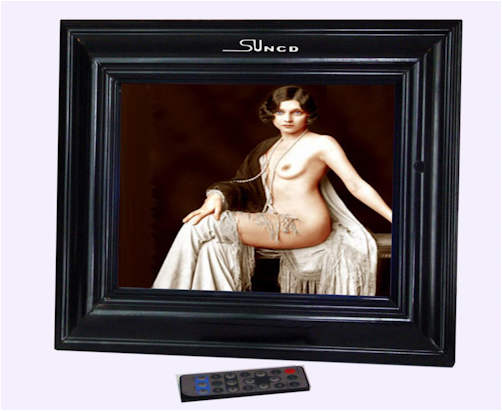
Tom Tweedel is a good friend with significant experience in China and has self-published several interesting volumes of his travels in China complete with many great images and informative narrative. Last year he visited Thailand for the first time and I had a great time showing him around the area. Somehow he found time to put together a like 340 page book of his travels around Thailand and you can get your copy here! I've got a copy of this book and I can tell you it's well worth it, especially for first time travelers or if you haven't seen more of Thailand than downtown Bangkok.
When Tom agreed to become part of our small select product review team I was both excited and grateful. I hope you enjoy this and future reviews by Tom. For those whose plans include extended travel in Thailand and China I’d recommend contacting Tom and inquiring into obtaining copies of his books. Tom Tweedel is an Austin, TX based photographer and can be reached at: tomsds@austin.rr.com
Digital Photo Frames
Digital Photo Frames have been around a while now, like all electronics they continue to evolve in features, ease of use, quality and price. Recent developments have taken them beyond being just a photo frame to being a media player capable of music, movies, pictures and even accessing net based content. Before too long we will probably see the high end units turn into lower cost, corded versions of an media tablet. If you think about it an I-pad with a properly tuned App for organizing and doing slideshows is really the ultimate digital photo frame, except it’s a tad pricey to dedicate to that application.

Digital Photo Frames have several nice advantages. The most obvious is the ability to look at a large number of photos in one location. Most units except external memory which means you can have tens of thousands of photos on tap and ready to. Adding more photos are as easy is copying them to a card or memory stick. Higher end units even have Wi-Fi access.
This ability to easily look at so many gives them incredible utility and value. Most of us have hundreds, maybe thousands (or more) of photos that would be nice to look at. But given the time, effort, space and expense of getting printouts, finding frames and putting them somewhere most of those photos just sit around on the hard drive eventually getting lost in the clutter or data related disaster. Even those photos that do make it to the light of day are usually restricted to the “A” list of your standard of perfection.
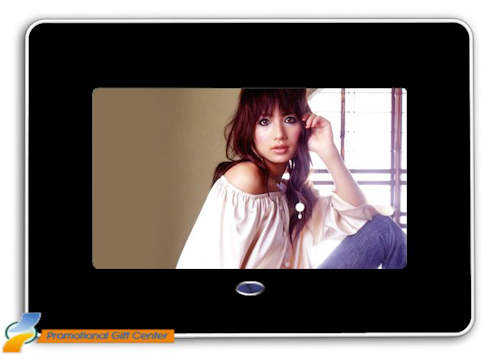
With a digital frame suddenly your ability to enjoy your photos explodes. Want to see a couple of hundred pictures? No problem. You’re not limited to the crown jewels or the best of a series. Bring them all over and enjoy. As you look a photo several times over a period of days in a different context you’ll be surprised at the little details that you’ll notice. Your pictures will take on new value and meaning to you.
Frames also make great gift ideas for the technologically challenged. As long as they can plug it in and flip the switch they can enjoy. Grab a memory card, load it up with a few thousand pictures of the kids and ship it off to the grandparents. When you visit bring a fresh card and swap it out to keep them up to date.
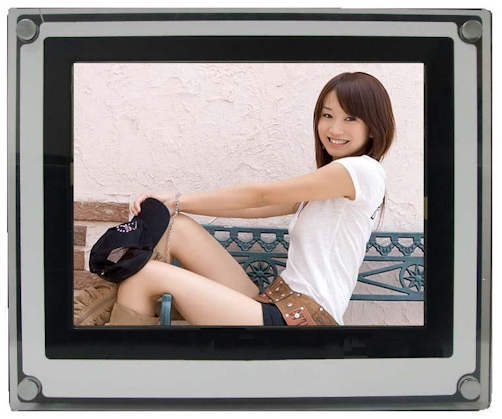
Digital Photo Frames do have their drawbacks. One is that they require power. In most cases this means a power cord. Some units have an internal battery but its limited, you’re going to need a plug if you want to enjoy it all day. That tethering restricts their use for wall mounted applications due to dangling cords and bulging power supplies.
For the discerning viewer the resolution, quality, color shift and dynamic range of the displays are like your worst cheap, glossy, oversaturated LCD monitor nightmares come to life. These are consumer grade appliances, not professional grade tools. Set your expectations accordingly.
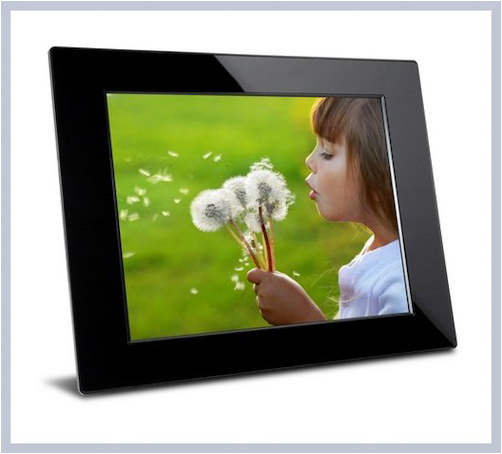
Digital Photo Frames are best used in places where you don’t have a lot of space and a cord isn’t a problem. That makes them ideal for lamp tables, night stands and at the office. Due to their thickness and power requirements they are better off being free-standing than hanging on something.
Features
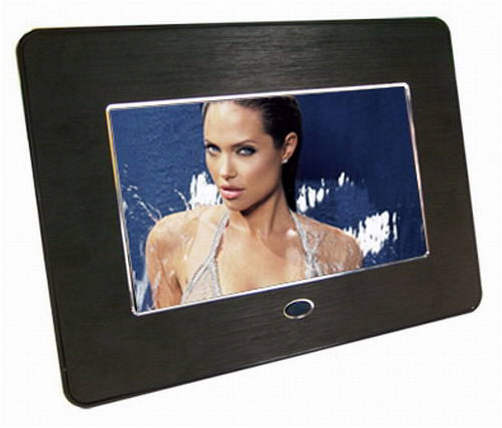
There are a number of features to consider when getting a frame:
Size
The size of these units is measured in inches, but this measurement comes from the same people who give us monitor measurements. What’s the diagonal distance across the frame. You might think a 7” frame would be perfect for a 5×7 photo but you’d be wrong. A 12” Frame gives you the same real estate as an 8×10 print.

Aspect Ratio
When choosing a frame you need to select one with an aspect ratio that fits your pictures. Most frames are either 4:3 or 16:9 (widescreen). Most point and shoots and non-SLR digital cameras use the 4:3 aspect ratio. The Widescreen 16:9 ratio is aimed at the HD Movie crowd because all the “cool” cameras these days shoot widescreen HD video (or claim to anyway).
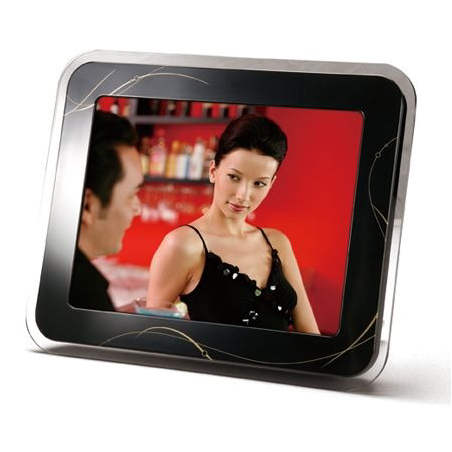
If you do the math 4:3 is 1.25 to 1 (every 1.25 of length is an inch of height.)
16:9 is 1.77 to 1 (every 1.77 inches of length is an inch of height).
SLRs are 1.5 to 1 (every 1.5 inches of length is an inch of height).
You might think about this depending on your photo source.
If you have a 4:3 camera a widescreen is going to have significant black space on either side. If you have a SLR a 4:3 is going to crop your images to something very close to a 8×10. If you have an SLR a widescreen is going to leave black space on either side.
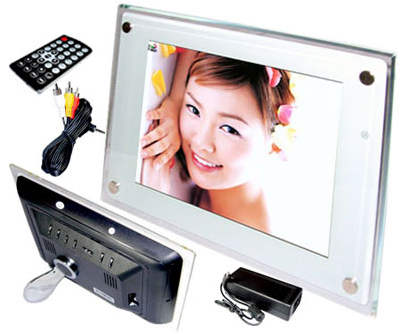
Resolution
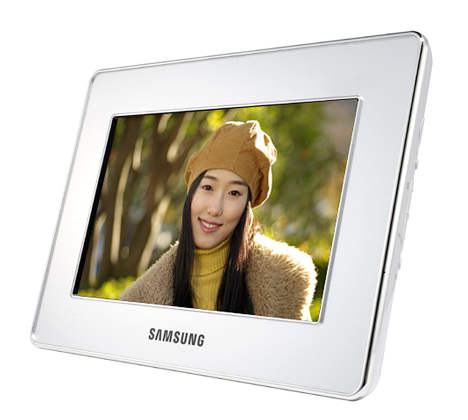
Related to size is resolution in pixels. Again we go back to computer monitors for resolutions like 640×480 or 800×600 or 1024×768 for the 4:3 ratio frames.
Picking your size vs. resolution is important. You might find a frame with a lot of real estate but without high resolution you’ll have to be further away to appreciate the view. My personal recommendation is to get the highest resolution in the smallest screen size you can for the sharpest image. But keep the size of your display area in mind as well. That 15” frame probably isn’t going to go well on your already overcrowded desk at work.
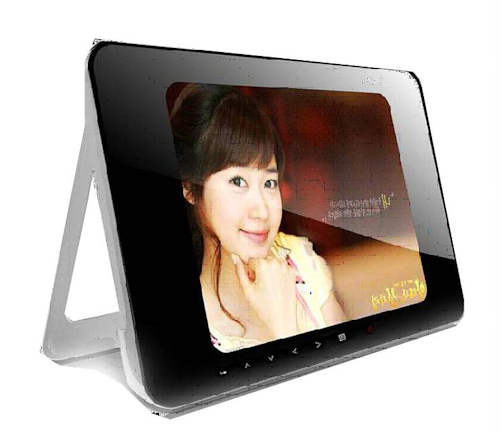
Internal Memory/Supported Formats
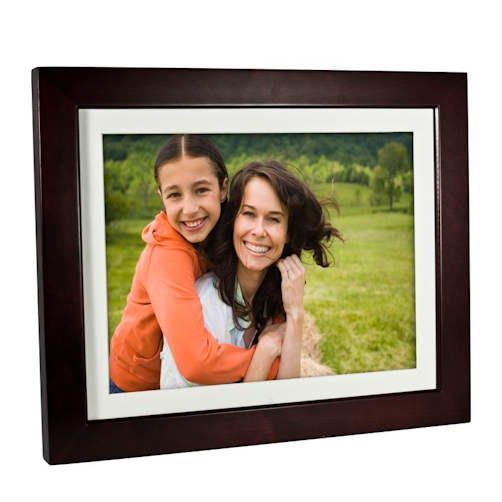
Most frames have some degree of internal memory from a few hundred K to a few Gigs. As long as the frame accepts a memory card you can use this isn’t all that important with multi-gig cards costing less and less. At the resolution of the frame a single gig can hold thousands of images. Make sure you get a unit that can read common card types (SD and its successors is the norm).
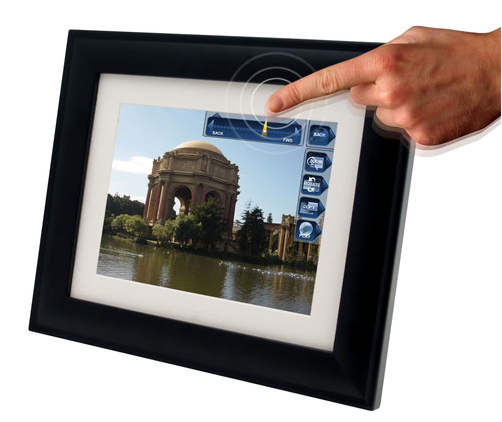
Auto Rotation
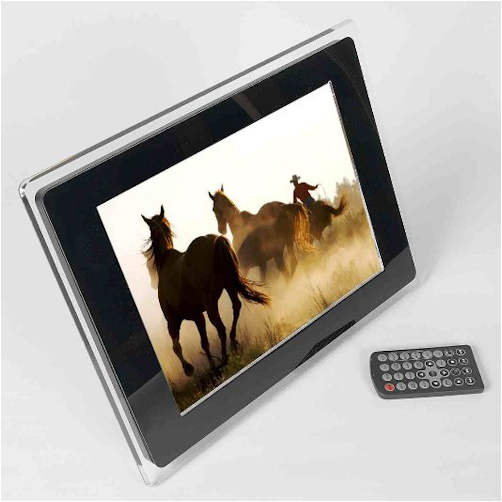
You’ll want a frame that has an orientation sensor and will auto rotate the pictures accordingly. That way your 8×10 pictures of the kids won’t show up sideways and your lush landscapes will display properly as well.
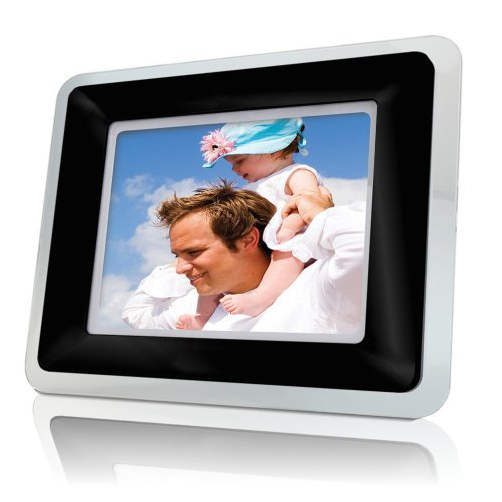
Timer
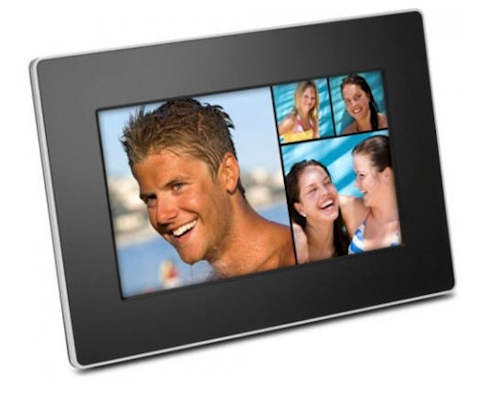
Chances are you’re not going to have a chance to look at this thing 24/7. Find a frame that has a timer feature on it. You can set it to turn on and off at specific times. This will save on electricity as well as preserve the life of your unit (LCDs dim with age).
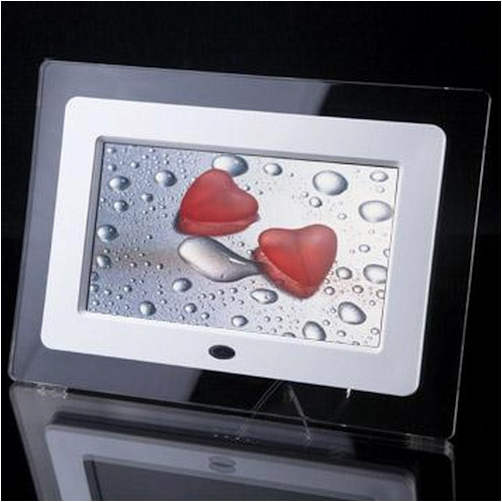
Ease of Use
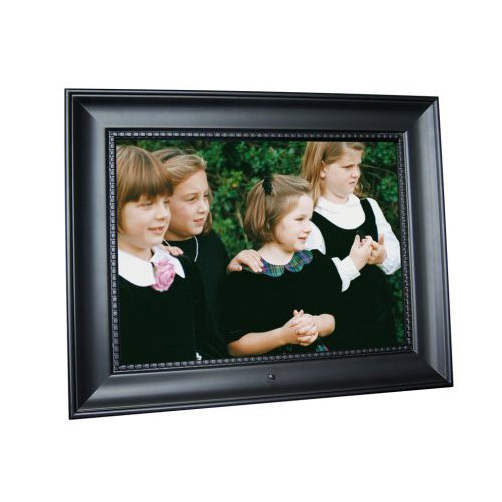
This depends on how determined you are. If you’ve ever had to adjust a monitor with only 3 buttons to access all controls you know how much “fun” this can be. Select a unit that has a thoughtful interface. Most units come with remotes but it’s only a matter of time before you lose it. Think about how to change things then.
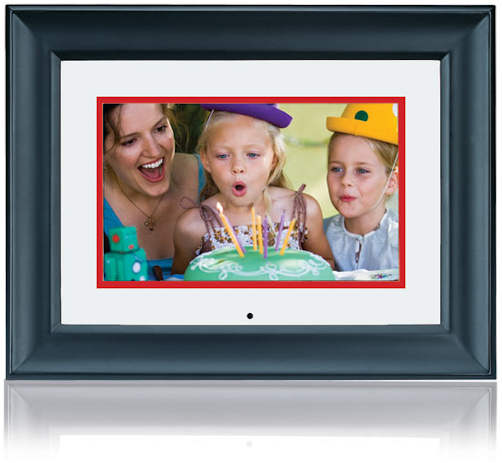
Build Quality and Service
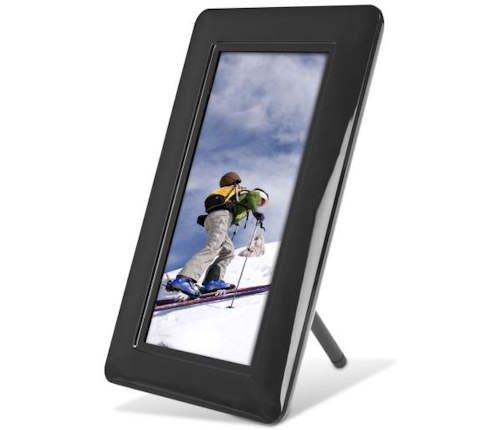
Understand that these things are basically “photo appliances” made as cheaply as possible by peasant labor in some factory in China. If you think about it on a fundamental level you are getting a low rez LCD monitor, a card reader, some internal memory, a simple operating system and the guts to put it all together and make it run for less than the cost of a cheap LCD monitor. Not much margin for quality there.
Check your favorite review websites to see what percentage of the reviews cover Dead On Arrival conditions (most common failure) and what luck the unfortunate consumer had dealing with support and returns.
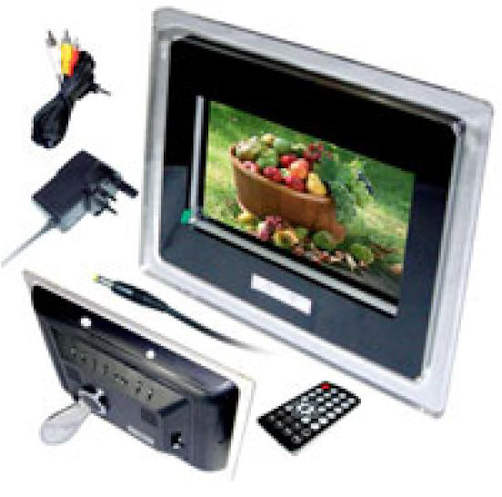
How does it look?
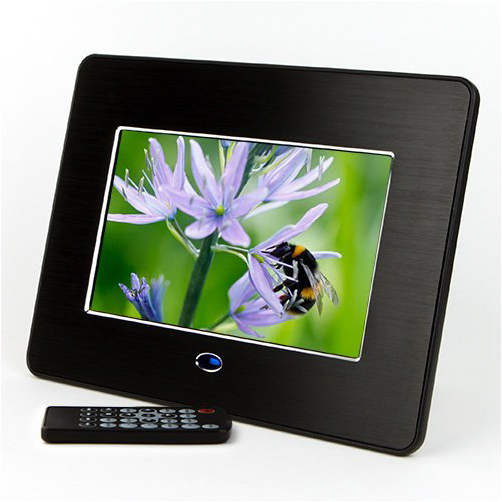
Take a good look at it; some of these units have Faux matting, snap on color frame covers, wild frame sizes compared to your screen real estate and more. Get something that fits your taste and space.
Slideshow

Most frames have a slideshow function, though some have a limited number of pictures or difficulties using more than one folder. Make sure the slideshow is up to how you want it, either sequential, random or both.
“Other Features”
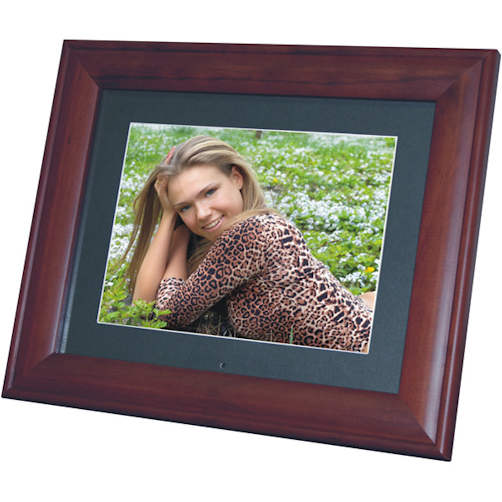
Ready to go beyond pictures? Some play MP4/WMV type movies. Keep in mind that codecs and processing requirements for movies are all over the place, don’t be surprised when it doesn’t run your movie. Especially that Widescreen HD movie.
Others play MP3 to your slideshow, that’s pretty standard but you’re going to have cheap speakers at best. Some allow you access the net via Wi-fi to look at pictures. Sounds cool but the interface is often problematic (enter your 16 digit alphanumeric WEP key using the up/down arrows..)
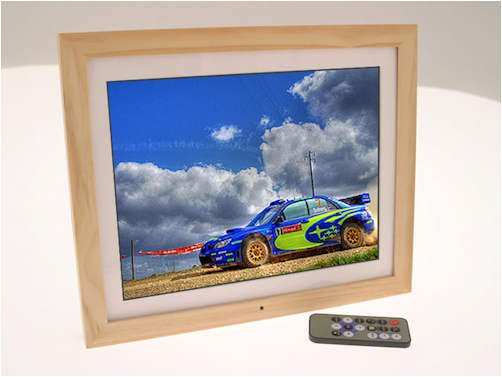
It’s a lot to think about but in the end you’ll end up with something that gives life to new photos and you can enjoy every day.
Photography News of Interest *menu
There seems to be controversy over Russia’s choice of mascots for the winter Olympics. Really? Only the Russians could find controversy over such cute little guys as these.


Prince Harry’s car hits royal photographer who requires hospitalization. Wow, the job gets more dangerous all the time. And to top it off they’re calling us “snappers?” Hmm..

Lined up Disney Photography, a cute gallery shows the price kids pay for coming to see Disney characters. Why would anyone want to show us why Disneyland can suck? Sigh..

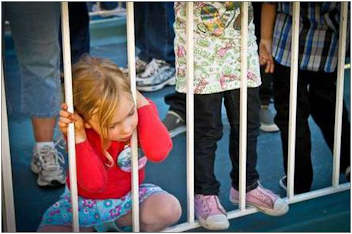
Another interesting gallery showing Eerie Draped Photography. Brendan George Ko shoots hidden models in a surreal shoot. Hmm.. this is interesting, but why?

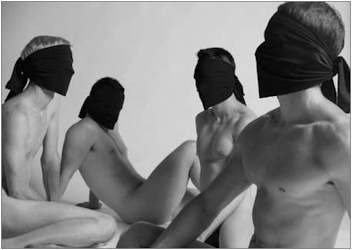
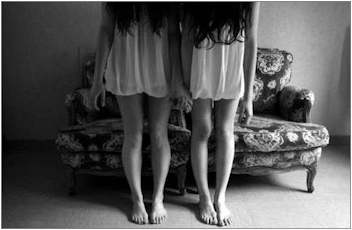
NEC PA301w Review from AnandTech. The baddest 30-inch Display Around. That about says it all. The 24” PA241w and the 27” PA271w have both been extremely popular with imaging professionals, so it comes as no surprise the newest addition to this series rates highly.

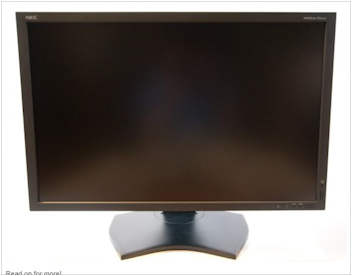
The Intel 510 series is reviewed by AnAndTech. This is Intel's latest entry into the very competitive SSD market and it appears to be a very solid entry. You’ll want to give it due consideration if you’re in the market for a SSD.

Pure Overclock reviews the new OCZ Vertex 3 and the results quickly place the new Vertex 3 as the SSD to beat. 550mbps reads, 520mbps writes, this drive is operating at the fringes of its SATA III interface. If you haven’t used a SSD before, you’d be shocked by how much performance is gained through the proper use of one of these top SSD’s.

Olympus updates firmware for the E-5, E-PL2, and XZ-1 models. The updates resolves minor bugs relating to the LCD and flash.

Readers Submissions *menu
Steve:
You might enjoy pictures taken at Truckee California Feb 13-16, 2011.
There was a 7 day storm just prior to us going up to the house. The ground was partially bare around the house before the storm hit.
After these pictures were taken we received another 3-4 feet of snow in 36 hours.
Rented snow mobiles and went with a guide around the rim of Squaw Valley at about 9000 feet. At 9 am that morning it was 0 deg F (-18 centigrade) but it warmed up to 20 degrees F by 11 AM.
As you can see the dinning room windows were covered with snow and the deck had about 7 feet.
It will be a real change to the 95 plus F when we arrive in BKK next month.
I purchased a GOPRO helmet cam for my Granddaughter to use with her down hill and cross country skiing. (see attached pictures) It is small, sturdy, waterproof and takes good video.
Rickster








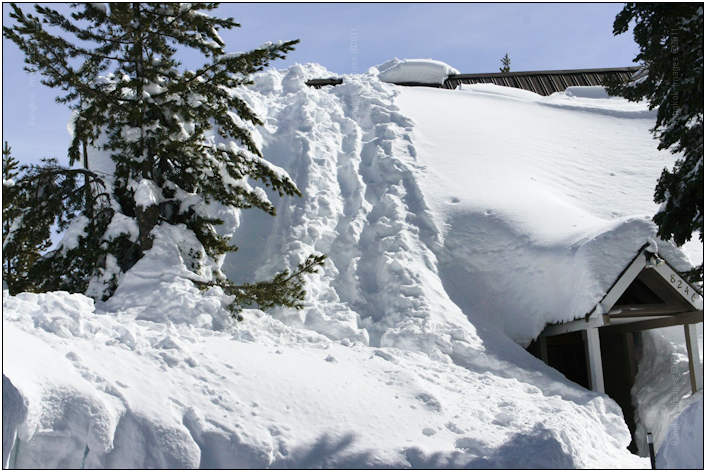
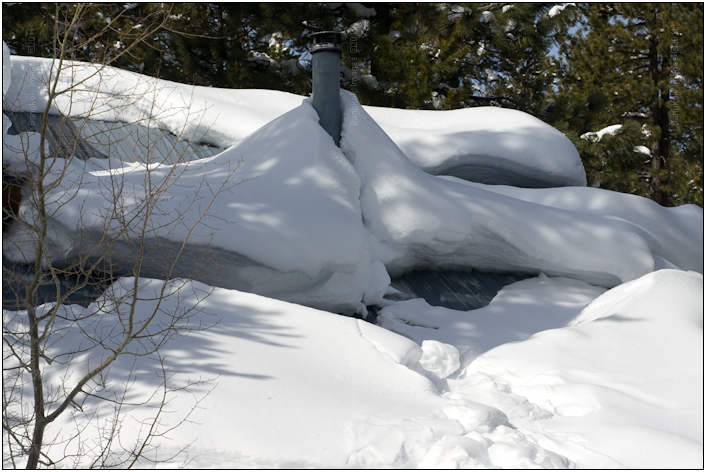
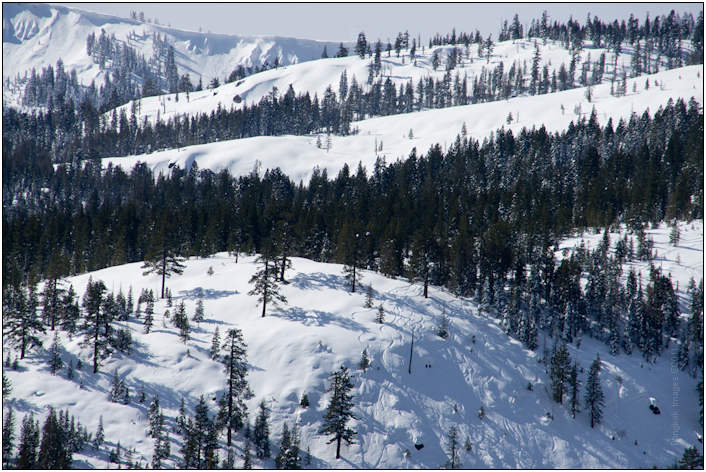
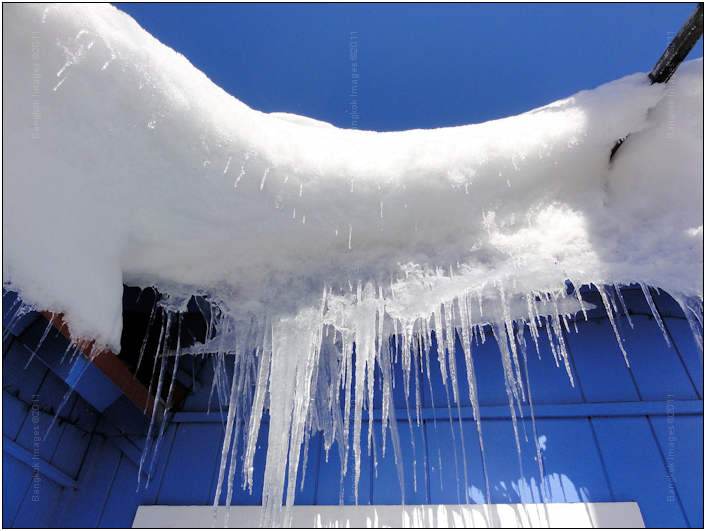
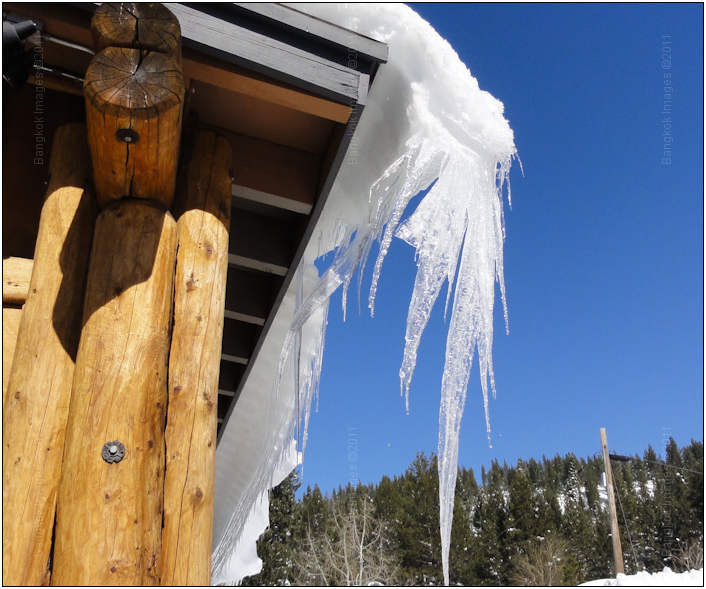
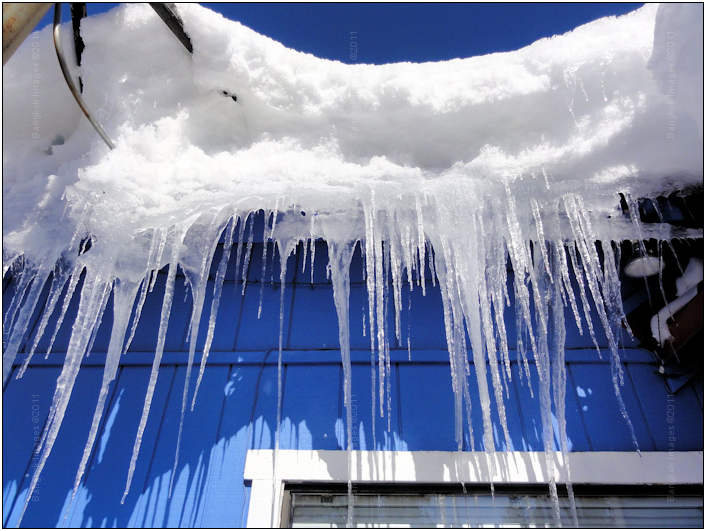
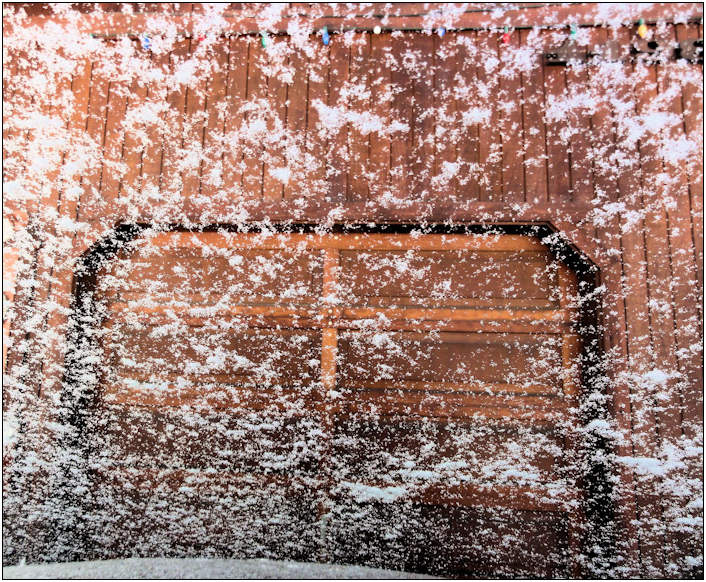
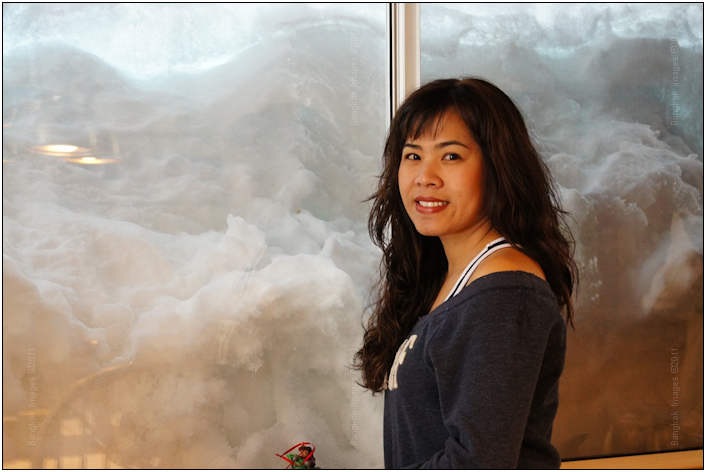
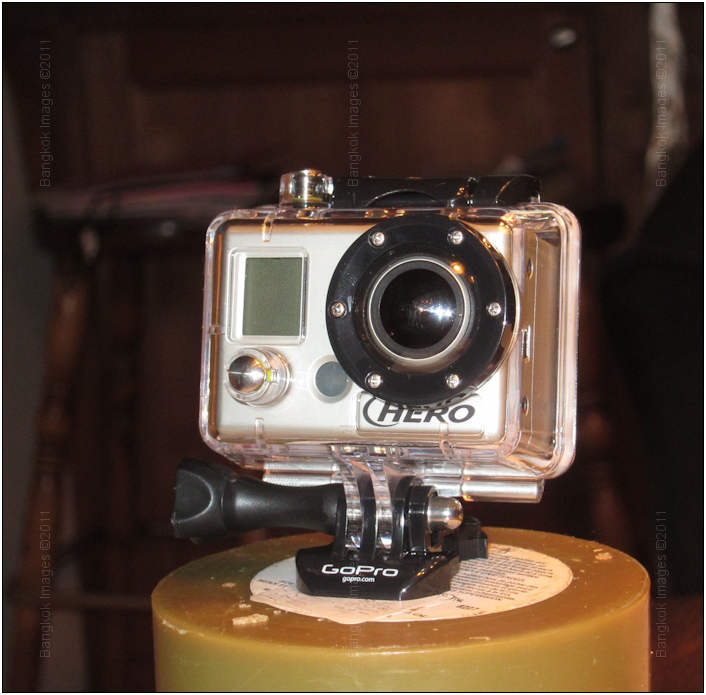
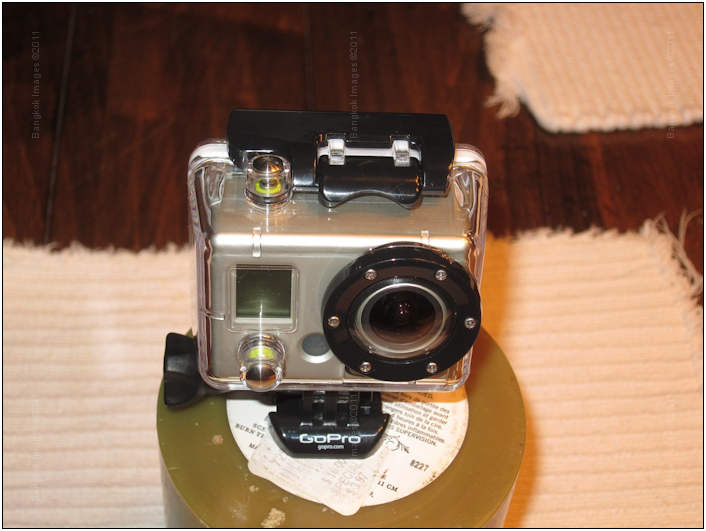
Rick –
Fun pictures! This reminds me of the first time I took my wife to the snow. She had a great time. Was this your wife’s first time?
The GoPro camera is becoming popular. One of my friends had one the last time we went out shooting. He strapped it to his head at the Railway Market and caught footage of the train approaching and passing. He was really thrilled with it. I’d love to see some footage of it to share with our readers.
Steve
I’d like to mention that everyone, myself included, is really enjoying the current trend of readers submissions. Everyone loves them, but remember we can really use more. I have only another week’s worth in my queue, so please take the time to put together a few images and words if you can and send them in. Thank you. info@BangkokImages.com
Readers Questions *menu
Hi Steve,
I'm looking for a SSD hard disk for my desktop machine where I would like to keep the regular HDD for data storage and only use SSD for OS (Windows 7), since I'm on a low budget I have planned on trying to stay within 4000 THB with the product purchased locally in Bangkok. My desktop is primary used for web browsing and maybe a VMware virtual machine running for some testing at times. It's just a low end Core 2 Duo 1.8GHz with 2GB ram but since I don't really have enough time (or don't take the time) for image editing so it works fine for me. Btw.I just changed the VGA card to HIS 5450 after your positive review.
So what SSD would you recommend from this list:
Intel X25-V 40GB http://www.bangkokimages.com/Articles/Equipment/entryid/631/Intel-X25-V-SSD-Review.aspx
Kingston SSDNow V Series (SNV125-S2)
Kingston SSDNow V Series (SNV125-S2BD)
OCZ Vertex2
Or more specific what product do you have experience with already.
I'm leaning towards either Intel or OCZ SSD but not really sure how to choose. From the research I done they both seem to have good remarks, but the OCZ is a fairly new product so there could be a surprise hidden.
As I said the budget should be around the 4000 bath mark, so that would mean 30-40 GB, that should actually be fine for my setup since I currently have 30GB system partition using approx 50%.
Thanks for the great website and news letter on Stick's site. I hope you are not leaving Thailand anytime soon as it seems Stick is considering…
Best regards
Kim
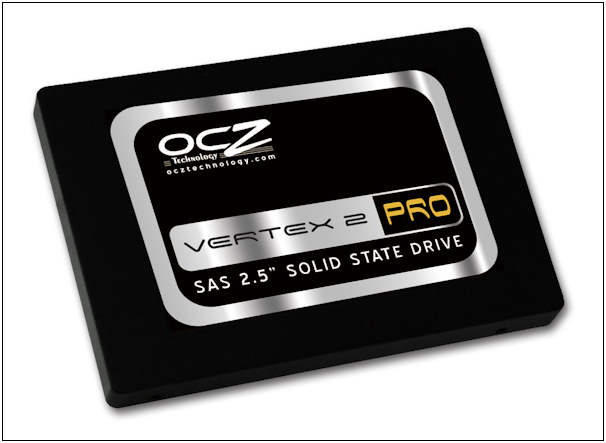
Hi Kim –
Nice to hear from you.
You’ve quite a bit of IT experience!
Next to an adequate amount of RAM, an SSD will give you the most performance for the cost than any other upgrade out there. And consider, an SSD will remain valuable long after you retire your current desktop, so it might be worth getting a better/bigger one than planned.
From the list you gave, a list I notice includes the most popular models available locally, I’d say the OCZ and the Intel are the two best choices. The Vertex 2 will give you better performance than the Intel. Both support TRIM and both have 3 year warranties if I’m not mistaken. So the Vertex 2 unless cost comes into play. The Vertex 2 is a mature product, and in fact much better performing Vertex 3 will be out soon as they’re now currently in reviewers hands. I’m not fond of the Kingston SSD’s, they underperform for their cost.
Something else to keep in mind, you already know that once a mechanical hard drive becomes more than 50% full, it starts to lose performance. SSD’s experience this too, but more towards greater than 80% full. So don’t plan on using your SSD to full capacity, and don’t forget to factor in the size of your page and cache files which can really benefit from the speed advantages of an SSD.
If you won’t be installing a fresh install on your new SSD, and plan on just restoring a backup copy/image, be very careful on sector size. Win7 automatically sets this correctly, but old images upgraded from XP or Vista might not be the right size.
Some tips: Make sure the new SSD is set up as an AHCI driver in your system BIOS, and you’re using the Microsoft AHCI 1.0 driver. This really makes a difference in performance. Also, turn off any disk caching, it’s no longer needed.
Thanks for reading the column. It’s always good to get feedback.
Let me know how this works out for you.
Steve
Please submit your questions to info@BangkokImages.com All questions will be answered and most will show up in the weekly column.
A Snapshot of Bangkok Images Week in Review *menu

This week was fun, I made it down to Bang Chang and reacquainted myself with the area and managed to get a few nice pictures in the process. I’ll be writing a feature on the visit soon.
Positive comments continue to pour in about our new look and much faster more interactive site. If you haven’t already checked it out, visit www.bangkokimages.com
to see my latest galleries, share your own galleries, participate in the forums,
and scour our large repository of photography related articles
. The “What’s New”
page continues to be very popular with almost daily updates and interesting content.
The Readers Submissions queue is now officially empty. If you have any images you’d like to share please send them in. If you think you have material for a feature contact me and I’ll do what I can to help you put it together. Your contributions are appreciated by everyone.
Infocus Blog, No Other Lifetimes *menu

Canon 1ds Mark II, 16-35mm F2.8L USM @F11 1/160th 16mm ISO 100
Occasionally in life we’re faced with choices of serious import. Can you mentally review your life and come up with the decisions you made which had the most impact on your life? Friends you’ve made, decisions about your education, employment
opportunities, relationships? Or have the decisions with the greatest impact on your life been what you thought at the time were small inconsequential decisions which later led to events you never imagined?
In truth good judgment comes from experience, and a lot of that comes from bad judgment. We make decisions every minute of every day, so many that we often pass over those of the most importance without cognizant consideration.
So when a decision you know is going to be important comes along, and within limits you have all the time in the world to think about it, how do you choose? This my friends is where your priorities in life define your character.
You choose by that which is most important to you. Money, sex, career, good times, are all powerful motivators. For some the only motivators. Forgive me for not believing these motivators are on the top of the list for those of ‘good’ character. These all focus on the individual. There is much more.
Priorities which focus on others, even if at the expense of self, are most often the priorities of someone with good character. God, country, family, friends, the list of selfless priorities is long.
As individuals we must learn to balance the self and selfless motivators to build our lives and this in turn defines our character. We need to take care of ourselves, but we’re obligated through God, country, family, friends.. to take care of others.
Years ago I was sitting on a seawall in Yomitan and had just arrived at this point in my decision making process. It was right then when an old Japanese man walking past stopped and looked straight at me. He didn’t look through me, he looked in
me. And then he said in Japanese:
"There are no other lifetimes but this one.."
And he turned and kept walking. I never saw him again.
I took this to mean that we most often only get one chance to make the right decisions, so we’d better prioritize the priorities.
I’m doing that, and I’ll let you know more soon.
Until next time..




